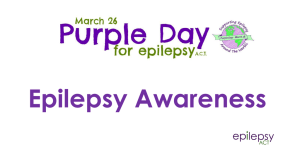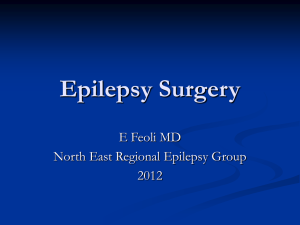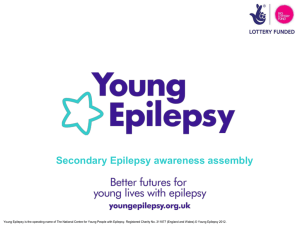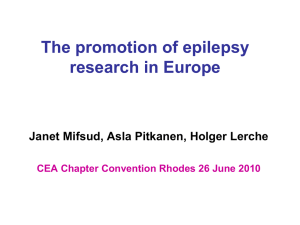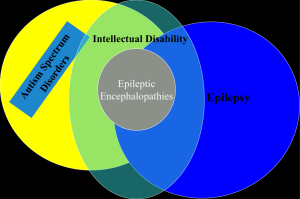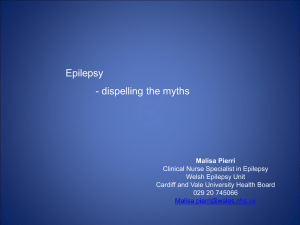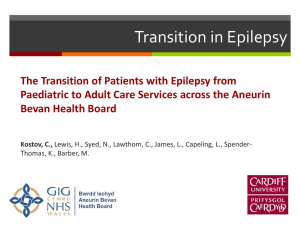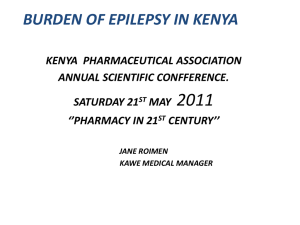07. Neurological lessons confidential enquiry findings Dec
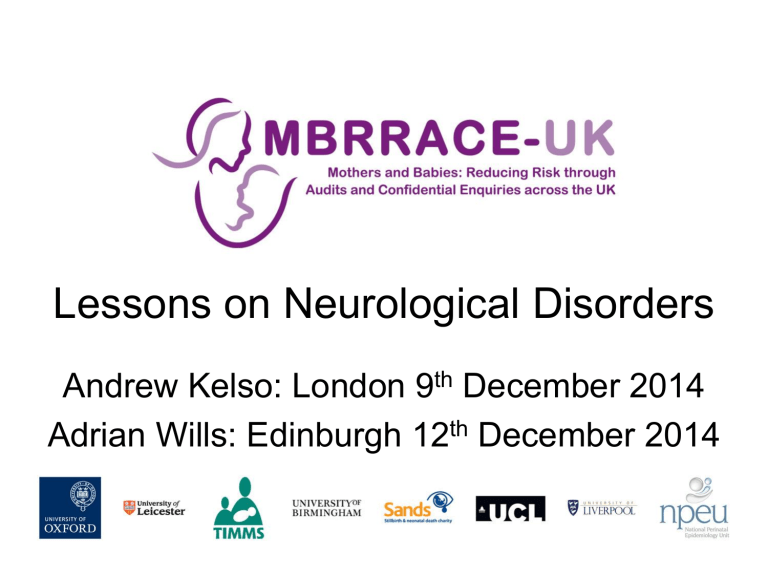
Lessons on Neurological Disorders
Andrew Kelso: London 9
th
December 2014
Adrian Wills: Edinburgh 12
th
December 2014
Neurology
Epilepsy:
14 deaths
0.4 per 100000 maternities
Stroke:
26 deaths
Mostly haemorrhagic
0.75 per 100000
STROKE
Haemorrhage:
• 13 women with subarachnoid haemorrhage,
• 13 with intracranial haemorrhage
• The majority presented with sudden collapse no warning i.e. no opportunity for intervention
Case 1
• Known migraneur, seen at term complaining of headache, blurred vision
• No documented neurology exam
• Re-admitted 1 week later, resuscitated by paramedicsurgent C/S, diffuse SAH, died
• First presentation may have been a sentinel bleed?
• Importance of Liaison, equipment,
Nimodipine
Case 2
• Admitted for induction
• BP 140/95
• Given Dinoprostone gel
• Syntometrine at delivery
• Sudden severe headache, seizure, asystole-SAH
Oxytocin alone (without ergometrine) is the drug of choice for the routine active management of the third stage of labour
NICE CG107, CG55
Ischaemic Stroke
Rare
0.03 per 100 000 maternities
Neither pregnancy, caesarean section delivery nor the immediate post-partum state are absolute contraindications to thrombolysis (intravenous or intra-arterial), clot retrieval or craniectomy.
Case 1
• Weak leg 2 weeks postpartum plus headache
• Migraine diagnosed!
• 6 hours later exacerbation
• Left MCA infarct
• No tpA
• No craniectomy
KEY MESSAGES
• Pregnancy should not alter the standard of care for stroke.
• All women, pregnant or not, should be admitted to a
Hyperacute Stroke Unit.
• Neurological examination including assessment for neck stiffness is mandatory in all new onset headaches or headache with atypical features, particularly focal symptoms.
• Neither pregnancy, caesarean section delivery nor the immediate post-partum state are absolute contraindications to thrombolysis (intravenous or intraarterial), clot retrieval or craniectomy.
Epilepsy
• Epilepsy commonest serious neurological disease
• 1% of UK population
• Suggestion that seizure related deaths (inc
SUDEP) more common in pregnant women
• Previous reports expressed concern regarding use of lamotrigine in pregnant women
• Mortality 0.4 per 100000 pregnancies
Epilepsy
• The death rate from epilepsy in pregnancy
( 0.40 per 100 000 ) is now higher than the death rate from hypertensive disorders in pregnancy
( 0.38 per 100 000 )
Pre-conception counselling
• NICE guidance makes strong recommendation that pre-conception counselling for all women and girls of childbearing age
• Lack of evidence that this available to women that died
• Multi-disciplinary approach required – its everyone’s responsibility
• Opportunistic value of counselling for future pregnancies
Multi-disciplinary and expert care
• Value of Epilepsy nurse specialists increasingly recognised
• Ideally placed to integrate with a number of different disciplines
• Emphasis on psychosocial outcomes
• Reduce admissions
• Improve medication compliance
• More responsive service
• Epilepsy nurses and other specialists could have been used more effectively for the women that died
Delays in care
• Pregnant women with epilepsy need prompt and responsive epilepsy care, including for new referrals
• Usual out-patient waiting times may not be appropriate
• Other barriers may prevent prompt engagement (chaotic lifestyle, language problems)
• Pregnant women with epilepsy should be seen promptly by an epilepsy specialist as soon as possible
• The specialist could be an epilepsy nurse
A woman with a diagnosis of childhood epilepsy and several years of seizure freedom off medication had a recurrence of tonic clonic seizures in pregnancy.
Referral to an epilepsy specialist was made by her GP but she died from drowning associated with a tonic clonic seizure before she was reviewed, several months after her referral.
She was not prescribed AEDs
High risk patients
• Women with epilepsy require diligent medical and nursing care during hospital admissions
• A policy of never nursing women with epilepsy in single rooms may be life saving
• Medical and nursing teams should always be aware of the potential effects of pregnancy and its complications on a woman’s epilepsy
• Pregnant women with epilepsy are still not routinely identified as a high risk group, both in outpatient and inpatient settings
A woman with epilepsy was admitted to hospital in early pregnancy with hyperemesis gravidarum
She was placed in a single room
She did not see a senior doctor for the entire 5 day admission
She did not see any doctor for the 3 days prior to her death
Hypokalaemia was identified but not treated
She died of SUDEP on day 5 of her hospital admission
Anti-epileptic drugs
• Previous enquiries have demonstrated a relationship between lamotrigine and maternal death
• Possible co-factors could include epilepsy syndrome, falls in lamotrigine levels during pregnancy, or direct effect of the drug itself
• This report does not demonstrate such a strong relationship as in previous reports
• Greater understanding of metabolism and effects of
AEDs in pregnancy required
• EMPIRE study results awaited
Sudden Unexplained
Death in Epilepsy
(SUDEP)
• SUDEP remains predominant cause of death in epilepsy
• Antenatal and postpartum
• Estimated risk of SUDEP higher than expected in pregnancy than expected
• Women and their families should be expressly counselled regarding risk
• Modifiable factors (first aid, recovery position, not sleeping alone, AED compliance) should addressed, including in the post-partum period
Bathing and drowning
• Death by drowning still occurs
• 2 deaths in this series due to drowning
(including one washing hair over edge of bath)
• Entirely preventable
• All women need robust advice regarding risks of bathing
A woman was found kneeling on the bathroom floor having drowned with her head in a bath of water.
She had been washing her hair, and showed signs of having had a generalised seizure.
Consensus
• Lack of consensus on how epilepsy care can and should be provided
• Obstetric, neurology and primary care have different priorities
• Can’t move forward without agreeing what best care should look like
• Basis on which to commission appropriate services
Recommendations
• Epilepsy remains a high risk condition in pregnancy and should continue to be managed as such in antenatal and postnatal care
• Multi-agency evidence based operational guidance is urgently required to standardise and improve the care of pregnant women with epilepsy
• Services should be commissioned and organised to support joint obstetric and neurological care of women with epilepsy during pregnancy
• Pre-conception counselling for women with epilepsy is not always provided effectively and should be robustly delivered in all care settings on an opportunistic basis
• Sudden Unexpected Death in Epilepsy (SUDEP) remains the major cause of death in pregnant or postpartum women with epilepsy, and further research is required to inform risk reduction strategies
